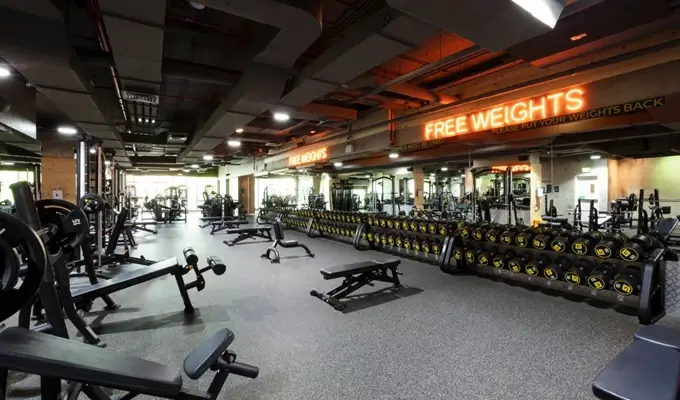Exercise and Cancer: Unlocking the Benefits

SIGN UP FOR YOUR FREE DAY PASS TODAY!
For anyone faced with a cancer diagnosis, hope often rests on finding ways to improve longevity and well-being.
While treatments like surgery and chemotherapy play a crucial role, groundbreaking research highlights another powerful ally in the fight against cancer—exercise.
The results of the phase 3 Colon Health and Lifelong Exercise Change (CHALLENGE) trial, recently published in the New England Journal of Medicine, illustrate how physical activity can enhance cancer-free survival and reduce mortality.
This study bolsters growing evidence that movement isn't just about fitness—it can be life-transforming.
Rea Also: New Health Rules in Dubai for Medical Fitness Tests
Key Findings From the CHALLENGE Trial
Dr. Annu Susan George, Consultant in Medical Oncology at Medcare Royal, explains the significance of the CHALLENGE trial. “As early as 2006, observational studies hinted that physical activity after a colon cancer diagnosis reduces recurrence and death risk.
But the CHALLENGE trial is revolutionary because it brings randomized controlled trial evidence.”
The study involved patients who had completed treatment for stage III or high-risk stage II colon cancer. Participants were divided into two groups:
- Health Education Group – Received general wellness resources.
- Exercise Program Group – Took part in a structured, three-year aerobic exercise program with regular support.
The results were remarkable:
- The exercise group saw a 28% lower risk of recurrence, new cancer, or death.
- Overall mortality was reduced by 37%.
- Benefits included fewer recurrences of colon cancer and a reduced risk of new cancers such as breast, prostate, and colon.
- Age was not a limiting factor; even participants over 60 experienced significant advantages.
- The positive outcomes weren’t tied to weight loss but stemmed directly from physical activity itself.
Dr. George notes, “This proves exercise is far more than a well-being booster—it brings measurable survival benefits. However, it’s an add-on, not a replacement for surgery or chemotherapy.”
Movement’s Expanding Role in Cancer Care
A growing body of research showcases exercise as a potent tool across various types of cancer.
Meta-analyses reveal post-diagnosis activity reduces cancer-specific mortality by up to 31% across breast, lung, prostate, and colorectal cancers.
High muscle strength and cardiovascular fitness are linked to a 46% lower risk of death in advanced cancers.
For breast cancer patients, resistance training has been particularly effective in reducing inflammation, improving body composition, and supporting immune function.
Importantly, even modest exercise—approximately 11 minutes a day or 75 minutes a week—can lower overall cancer risk by 7%. For optimal protection, experts recommend 150 to 300 minutes of activity per week.
Decoding the Science Behind Exercise and Cancer
What makes physical activity so impactful? Research points to physiological mechanisms that affect cancer risk, progression, and treatment outcomes.
1. Strengthened Immune Surveillance
Exercise enhances immune system functionality, boosting the activity of natural killer cells and T-cells that identify and destroy cancerous or abnormal cells.
2. Reduced Chronic Inflammation
By lowering pro-inflammatory markers and increasing anti-inflammatory signals, regular physical activity creates a less hospitable environment for cancer cells to thrive.
3. Improved Insulin Sensitivity
Cancer cells often grow faster in insulin-rich environments. Exercise improves insulin regulation, limiting the conditions that promote cancer cell growth, particularly for breast and colon cancers.
4. Altered Tumor Microenvironment
Better blood circulation and oxygen delivery from exercise can slow tumor progression and improve treatment efficacy by influencing the surrounding tissues where tumors exist.
5. Hormonal Regulation
For cancers like breast and prostate, which are hormone-sensitive, movement helps balance estrogen and testosterone, reducing imbalances that might accelerate tumor growth.
How Much Exercise Is Enough?
According to the U.S. Centers for Disease Control and Prevention (CDC), adults should aim for:
- 150–300 minutes of moderate-intensity aerobic activity weekly, such as brisk walking, swimming, or cycling.
- Or 75–150 minutes of vigorous-intensity exercise weekly, such as jogging or high-intensity interval training (HIIT).
Strength training is equally important:
- Include resistance exercises at least twice a week to support muscle health and boost metabolism.
Even small, everyday changes—taking stairs instead of the elevator or a quick evening walk—can accumulate into meaningful health improvements over time.
The Big Picture
While exercise is a game-changing component in cancer prevention and care, it works best as part of a comprehensive approach that also includes proper diet, medical treatment, and lifestyle adjustments.
Dr. George emphasizes, “There’s a dose-response relationship—the more you move, the greater the benefits, up to a point. A supervised program after treatment can be especially valuable.”
From significantly reducing recurrence risks to improving quality of life, the science is clear—when it comes to fighting cancer and bolstering overall health, movement truly matters. The takeaway? Just keep moving. Every step counts.
Read Also: Senior Fitness Revolution in Singapore
Source: gulfnews
The opinions shared in the GymNation blog articles are solely those of the respective authors and may not represent the perspectives of GymNation or any member of the GymNation team.
GET YOUR FREE TRIAL TODAY





























































































